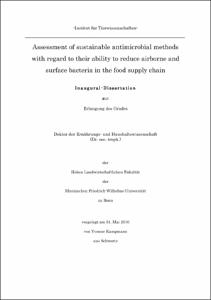Assessment of sustainable antimicrobial methods with regard to their ability to reduce airborne and surface bacteria in the food supply chain

Assessment of sustainable antimicrobial methods with regard to their ability to reduce airborne and surface bacteria in the food supply chain

| dc.contributor.advisor | Kreyenschmidt, Judith | |
| dc.contributor.author | Kampmann, Yvonne | |
| dc.date.accessioned | 2020-04-14T09:07:58Z | |
| dc.date.available | 2020-04-14T09:07:58Z | |
| dc.date.issued | 13.07.2010 | |
| dc.identifier.uri | https://hdl.handle.net/20.500.11811/4218 | |
| dc.description.abstract | The objective of this thesis was the assessment of antimicrobial methods with regard to their ability to reduce airborne and surface bacteria during processing and storage of perishable food. In particular, possible influencing factors on the rate of antimicrobial activity were investigated, such as temperature, food residuals and microflora. Based on the results, an evaluation scheme was developed for the assessment of antimicrobial techniques with regard to the prevailing requirement profiles for the respectively application area. The study focuses on the application of materials containing silver for reduction of surface bacteria and on the use of ionization for the reduction of surface and airborne bacteria. For the determination of the influence of selected factors on the antimicrobial activity of these both techniques (materials containing silver and ionization) the standard test procedure JIS Z 2801 (2000) was used in a modified form. By comparing colony forming units under the influence of the antimicrobial technique with the colony forming units at reference conditions, the rate of antimicrobial activity was determined. It became apparent, that both of the techniques examined were generally able to reduce surface and airborne bacteria. However, the rate of reduction was strongly dependent on the influencing factors of time, temperature, and the sensitivity of test organisms used as well as on the effect of possible food residuals on the surface. Thus, the application of the described techniques in contact with perishable food is only beneficial, if the available microbiological, material and environmental factors fit to the activity profile of the antimicrobial technique. Based on the results, an evaluation scheme was developed for the testing of antimicrobial methods as to their applicability for use in the food chain. The scheme gives priority to the integration of the influencing factors - material, microbiology and environment. | |
| dc.description.abstract | Bewertung dauerhaft antimikrobieller Verfahren im Hinblick auf deren Fähigkeit, Luft- und Oberflächenkeimgehalte im Bereich leicht verderblicher Lebensmittel zu reduzieren Ziel der vorliegenden Arbeit war es, antimikrobiell wirkende Methoden im Hinblick auf deren Eignung zur Reduzierung des Luft- und Oberflächenkeimgehaltes während der Verarbeitung und Lagerung von leichtverderblichen Lebensmitteln zu bewerten. Dabei galt es, insbesondere mögliche Einflussfaktoren auf die antimikrobielle Wirksamkeit, wie Temperatur, Lebensmittelrückstände und Keimflora, zu erforschen. Basierend auf den Ergebnissen wurde ein Prüfschema entwickelt für die Bewertung dieser Technologien in Hinblick auf das jeweilige Einsatzgebiet und den damit verbundenen, spezifischen Anforderungsprofilen. Im Fokus der Betrachtung lag die Anwendung von antimikrobiell wirkenden Silberadditiven in Werkstoffen zur Reduzierung von Oberflächenkeimgehalten sowie die Anwendung von Ionisatoren zur Reduktion von Oberflächen- und Luftkeimgehalten. Zur Ermittlung des Einflusses ausgewählter Faktoren auf die antimikrobielle Aktivität von Werkstoffen und der Ionisation wurde das Standardprüfverfahren JIS 2801 (2000) entsprechend modifiziert. Über den Vergleich des Keimgehaltes unter Einfluss der zu prüfenden Methode und des Keimgehaltes unter Referenzbedingungen wurde die Höhe der antimikrobiellen Aktivität bestimmt. Es konnte gezeigt werden, dass die analysierten, antimikrobiellen Verfahren grundsätzlich in der Lage waren, den Oberflächen- und Luftkeimgehalt zu reduzieren. Jedoch hing die Aktivität signifikant von den Faktoren Zeit, Temperatur, Sensitivität des verwendeten Testorganismus sowie möglichen Lebensmittelrückständen auf den Oberflächen ab. Der Einsatz der vorgestellten Methoden in Kontakt mit kühlpflichtigen Lebensmitteln ist somit nur vorteilhaft, wenn die mikrobiologischen, materialtechnischen und Umweltbedingungen während der Anwendung dem Aktivitätsprofil der antimikrobiellen Methode entsprechen. Basierend auf den Ergebnissen wurde ein Prüfschema zur Bewertung der Anwendbarkeit von antimikrobiellen Methoden im Lebensmittelbereich entwickelt. Das Schema stellt die Integration der relevanten Einflussfaktoren Material, Mikrobiologie und Umwelt entsprechend des Anwendungsprofils der antimikrobiellen Methode in den Vordergrund. | |
| dc.language.iso | eng | |
| dc.rights | In Copyright | |
| dc.rights.uri | http://rightsstatements.org/vocab/InC/1.0/ | |
| dc.subject | Silber | |
| dc.subject | Ionisation | |
| dc.subject | antimikrobiell | |
| dc.subject | Lebensmittelkontaktoberflächen | |
| dc.subject | Kühlschrank | |
| dc.subject | silver | |
| dc.subject | ionization | |
| dc.subject | antimicrobial | |
| dc.subject | food contact surfaces | |
| dc.subject | refrigerator | |
| dc.subject.ddc | 630 Landwirtschaft, Veterinärmedizin | |
| dc.title | Assessment of sustainable antimicrobial methods with regard to their ability to reduce airborne and surface bacteria in the food supply chain | |
| dc.type | Dissertation oder Habilitation | |
| dc.publisher.name | Universitäts- und Landesbibliothek Bonn | |
| dc.publisher.location | Bonn | |
| dc.rights.accessRights | openAccess | |
| dc.identifier.urn | https://nbn-resolving.org/urn:nbn:de:hbz:5N-22119 | |
| ulbbn.pubtype | Erstveröffentlichung | |
| ulbbnediss.affiliation.name | Rheinische Friedrich-Wilhelms-Universität Bonn | |
| ulbbnediss.affiliation.location | Bonn | |
| ulbbnediss.thesis.level | Dissertation | |
| ulbbnediss.dissID | 2211 | |
| ulbbnediss.date.accepted | 08.07.2010 | |
| ulbbnediss.fakultaet | Landwirtschaftliche Fakultät | |
| dc.contributor.coReferee | Stamminger, Rainer |
Files in this item
This item appears in the following Collection(s)
-
E-Dissertationen (1027)




